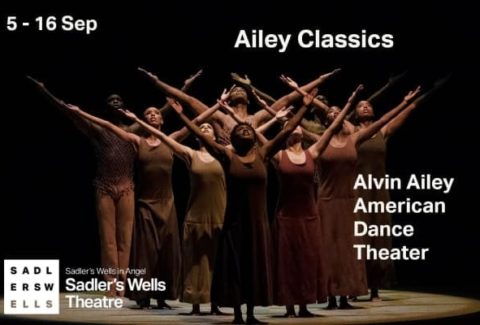The River by Alvin Ailey
By turns muscular and lyrical, The River is a sweeping full company work that suggests tumbling rapids and meandering streams on a journey to the sea. Ailey’s allegory of birth, life and rebirth abounds with water references, from the spinning “Vortex” solo to the romantic “Lake” duet, and from the powerful “Falls” quartet to the joyful “Giggling Rapids”. The choreography demonstrates Ailey’s admiration for classical ballet but retains the modern and jazz influences found in all his work. “The River shows Mr Ailey at his inventive best,” declared The New York Times.
The grandeur of the dancing is matched by the music, which was Duke Ellington’s first symphonic score written for dance. Ailey and Ellington collaborated closely on the piece. This new production features costumes newly designed for the first time since the 1970s.
Pas de Duke by Alvin Ailey
Pas de Duke is Alvin Ailey’s spirited modern dance translation of a classical pas de deux, originally created in 1976 as a showcase for Judith Jamison and Mikhail Baryshnikov. She was a reigning star of modern dance; he was one of the world’s most famous ballet dancers, having defected from the Soviet Union two years earlier. Ailey made brilliant use of the dancers’ physical and stylistic differences, crafting an elegant, flirtatious work that showed off their exuberance and virtuosity as they engaged in a playful game of one-upmanship.
The work is comprised of five solos and duets that require extraordinary technical facility, flawless timing, and strong acting skills. Since its premiere, it has been performed by generations of dancers who have each put their own unique twist on the choreography, and it has stood the test of time in part for how perfectly it captures the timeless sophistication of Duke Ellington’s jazz music. The New York Times has praised it as “one of those special dances that lives in new ways with each new set of performers.”
Cry by Alvin Ailey
Alvin Ailey choreographed his signature solo Cry as a birthday present for his dignified mother, and created the dance on his stunning muse, Judith Jamison.
Alvin Ailey’s mother and Jamison could both be considered the archetypal Ailey woman – a role that has been passed on to all the women in the Ailey ranks to whom Jamison has taught this solo.
In her autobiography Dancing Spirit, Jamison wrote: “Exactly where the woman is going through the ballet’s three sections was never explained to me by Alvin. In my interpretation, she represented those women before her who came from the hardships of slavery, through the pain of losing loved ones, through overcoming extraordinary depressions and tribulations. Coming out of a world of pain and trouble, she has found her way-and triumphed.”
Ailey dedicated this piece to “all Black women everywhere – especially our mothers.” In this three-section solo, the dancer, clad in a white leotard and long ruffled skirt, brings the audience on a journey of bitter sorrow, brutal hardship and ecstatic joy.
Revelations by Alvin Ailey
Using African American spirituals, song-sermons, gospel songs and holy blues, Alvin Ailey’s Revelations fervently explores the places of deepest grief and holiest joy in the soul. Ailey described the memories that inspired Revelations as “blood memories” because they were so strong, he felt they were part of him as much as the blood that ran through his veins.
More than just a popular dance work, it has become a cultural treasure, beloved by generations of fans. Seeing Revelations for the first time or the hundredth can be a transcendent experience, with audiences cheering, singing along and dancing in their seats from the opening notes of the plaintive “I Been ’Buked” to the rousing “Wade in the Water” and the triumphant finale, “Rocka My Soul in the Bosom of Abraham.” It is no surprise that it is the most widely seen modern dance work in the world.
Book Tickets
